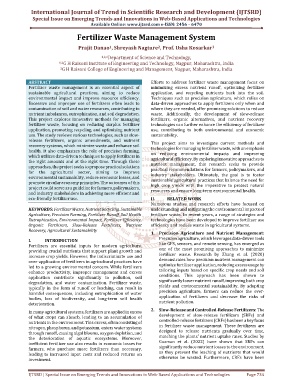Page 744 - Emerging Trends and Innovations in Web-Based Applications and Technologies
P. 744
International Journal of Trend in Scientific Research and Development (IJTSRD)
Special Issue on Emerging Trends and Innovations in Web-Based Applications and Technologies
Available Online: www.ijtsrd.com e-ISSN: 2456 – 6470
Fertilizer Waste Management System
Prajit Danao , Shreyash Nagture , Prof. Usha Kosarkar
1
2
3
1,2,3 Department of Science and Technology,
1,2 G H Raisoni Institute of Engineering and Technology, Nagpur, Maharashtra, India
3 G H Raisoni College of Engineering and Management, Nagpur, Maharashtra, India
ABSTRACT Efforts to address fertilizer waste management focus on
Fertilizer waste management is an essential aspect of minimizing excess nutrient runoff, optimizing fertilizer
sustainable agricultural practices, aiming to reduce application, and recycling nutrients back into the soil.
environmental impact and improve resource efficiency. Techniques such as precision agriculture, which relies on
Excessive and improper use of fertilizers often leads to data-driven approaches to apply fertilizers only when and
contamination of soil and water resources, contributing to where they are needed, offer promising solutions to reduce
nutrient imbalances, eutrophication, and soil degradation. waste. Additionally, the development of slow-release
This project explores innovative methods for managing fertilizers, organic alternatives, and nutrient recovery
fertilizer waste, focusing on reducing surplus fertilizer technologies can further enhance the efficiency of fertilizer
application, promoting recycling, and optimizing nutrient use, contributing to both environmental and economic
use. The study reviews various technologies, such as slow- sustainability.
release fertilizers, organic amendments, and nutrient This project aims to investigate current methods and
recovery systems, which minimize waste and enhance soil technologies for managing fertilizer waste, with an emphasis
health. It also emphasizes the role of precision farming, on reducing environmental impacts and improving
which utilizes data-driven techniques to apply fertilizers in agricultural efficiency. By exploring innovative approaches to
the right amounts and at the right time. Through these nutrient management, this research seeks to provide
approaches, the project seeks to propose practical solutions practical recommendations for farmers, policymakers, and
for the agricultural sector, aiming to improve industry stakeholders. Ultimately, the goal is to foster
environmental sustainability, reduce economic losses, and sustainable agricultural practices that balance the need for
promote circular economy principles. The outcomes of this high crop yields with the imperative to protect natural
project could serve as a guideline for farmers, policymakers, resources and ensure long-term environmental health.
and industry stakeholders in achieving more efficient and
eco-friendly fertilizer use. II. RELATED WORK
Numerous studies and research efforts have focused on
KEYWORDS: Fertilizer Waste, Nutrient Recycling, Sustainable understanding and mitigating the environmental impacts of
Agriculture, Precision Farming, Fertilizer Runoff, Soil Health fertilizer waste. In recent years, a range of strategies and
Eutrophication, Environmental Impact, Fertilizer Efficiency, technologies have been developed to improve fertilizer use
Organic Fertilizers, Slow-Release Fertilizers, Nutrient efficiency and reduce waste in agricultural systems.
Recovery, Agricultural Sustainability
1. Precision Agriculture and Nutrient Management:
I. INTRODUCTION Precision agriculture, which leverages data-driven tools
like GPS, sensors, and remote sensing, has emerged as
Fertilizers are essential inputs for modern agriculture,
one of the most promising approaches to minimize
providing crucial nutrients that support plant growth and
fertilizer waste. Research by Zhang et al. (2020)
increase crop yields. However, the indiscriminate use and
demonstrates how precision nutrient management can
over-application of fertilizers in agricultural practices have
optimize fertilizer application, reducing excess usage by
led to a growing environmental concern. While fertilizers
tailoring inputs based on specific crop needs and soil
enhance productivity, improper management and excess
conditions. This approach has been shown to
application contribute significantly to pollution, soil
significantly lower nutrient runoff, improving both crop
degradation, and water contamination. Fertilizer waste,
yields and environmental sustainability. By adopting
typically in the form of runoff or leaching, can result in
precision agriculture, farmers can reduce the over-
harmful consequences, including eutrophication of water
application of fertilizers and decrease the risks of
bodies, loss of biodiversity, and long-term soil health
nutrient pollution.
deterioration.
2. Slow-Release and Controlled-Release Fertilizers: The
In many agricultural systems, fertilizers are applied in excess
development of slow-release fertilizers (SRFs) and
of what crops can absorb, leading to an accumulation of
controlled-release fertilizers (CRFs) has been a key focus
nutrients in the environment. This excess, often consisting of
in fertilizer waste management. These fertilizers are
nitrogen, phosphorus, and potassium, enters water systems
designed to release nutrients gradually over time,
through runoff, causing algal blooms, oxygen depletion, and
matching the plants' nutrient uptake rates. Studies by
the deterioration of aquatic ecosystems. Moreover,
Guzman et al. (2022) have shown that SRFs can
inefficient fertilizer use also results in economic losses for
significantly reduce nutrient losses to the environment,
farmers, who purchase more fertilizers than necessary,
as they prevent the leaching of nutrients that would
leading to increased input costs and reduced returns on
otherwise be wasted. Furthermore, CRFs have been
investment.
IJTSRD | Special Issue on Emerging Trends and Innovations in Web-Based Applications and Technologies Page 734

